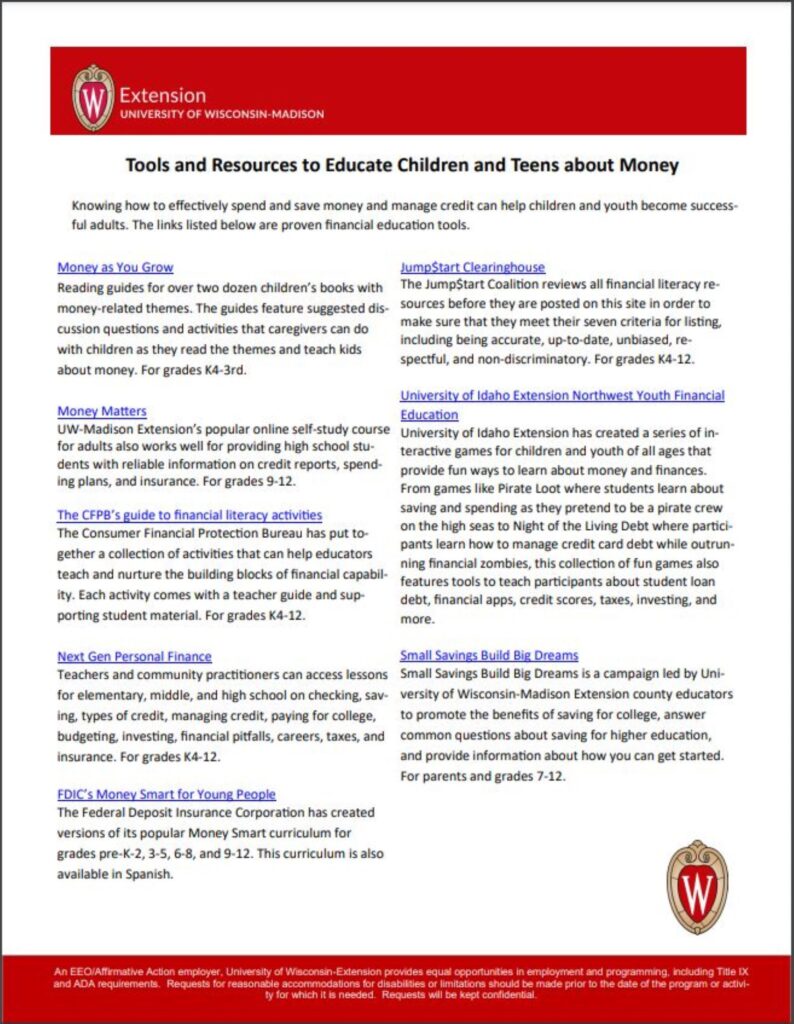In addition to the resources included throughout this website, the following links are to trusted resources about planning and paying for college.
UW-Madison Division of Extension Resources

- College savings fact sheet (also available in Spanish) – Summarizes the importance of college savings and describes different types of college savings accounts.
- Savings planning worksheet – Short goal setting exercise to help people develop a plan to start saving for college or add to existing savings.
- Getting Through Tough Times – Finding money to save for college can be challenging. This website provides a variety of tools and resources that families can use to help find money to save for college. The resources can also help individuals with student loans complete a budget so they can determine how much money is available for loan repayment.
- Money as You Grow – Parent guides for over two dozen children’s books with money-related themes. The guides feature suggested discussion questions and activities that caregivers can do with children as they read the themes and teach kids about money. For grades K4-3rd.
- Money Matters – UW-Madison Division of Extension’s popular online self-study course for adults also works well for providing high school students with reliable information on credit reports, spending plans, and insurance. For grades 9-12.
Resources for Teaching Kids and Teens about Money
The CFPB’s guide to financial literacy activities
The Consumer Financial Protection Bureau has put together a collection of activities that can help educators teach and nurture the building blocks of financial capability. Each activity comes with a teacher guide and supporting student material. For grades K4-12.
Next Gen Personal Finance
Teachers and community practitioners can access lessons for elementary, middle, and high school on checking, saving, types of credit, managing credit, paying for college, budgeting, investing, financial pitfalls, careers, taxes, and insurance. For grades K4-12.
FDIC’s Money Smart for Young People
The Federal Deposit Insurance Corporation has created versions of its popular Money Smart curriculum for grades pre-K-2, 3-5, 6-8, and 9-12. This curriculum is also available in Spanish.
Jump$tart Clearinghouse
The Jump$tart Coalition reviews all financial literacy resources before they are posted on this site in order to make sure that they meet their seven criteria for listing, including being accurate, up-to-date, unbiased, respectful, and non-discriminatory. For grades K4-12.
University of Idaho Extension Northwest Youth Financial Education
University of Idaho Extension has created a series of interactive games for children and youth of all ages that provide fun ways to learn about money and finances. From games like Pirate Loot where students learn about saving and spending as they pretend to be a pirate crew on the high seas to Night of the Living Debt where participants learn how to manage credit card debt while outrunning financial zombies, this collection of fun games also features tools to teach participants about student loan debt, financial apps, credit scores, taxes, investing, and more.
Small Savings, Big Dreams
Small Savings Build Big Dreams is a campaign led by University of Wisconsin-Madison Extension county educators to promote the benefits of saving for college, answer common questions about saving for higher education, and provide information about how you can get started. For parents and grades 7-12.
Online Resources – Planning and Saving for College
- Federal Student Aid (studentaid.ed.gov) – Provides a variety of information about planning and paying for college. Resources include a FAFSA4caster calculator that provides an early estimate of families’ eligibility for federal student aid.
- Free Application for Federal Student Aid (fafsa.ed.gov) – Official website for applying for federal student aid. Includes a variety of related resources.
- Wisconsin Department of Public Instruction Academic & Career Planning (ACP) (dpi.wi.gov/acp) – A student-driven, adult-supported process in which students create and cultivate their own unique and information-based visions for post secondary success.
- College Navigator (nces.ed.gov/collegenavigator) – U.S. Department of Education website that provides a college cost calculator and in-depth information about the cost of attending different colleges.
- Consumer Financial Protection Bureau’s (CFPB’s) “Paying for College” website (consumerfinance.gov/paying-for-college) – Tools and resources to help make informed financial decisions about how to pay for college from the CFPB.
- Look Forward to Your Future (lookforwardwi.gov) – An undertaking of the Wisconsin Department of Financial Institutions (DFI). Provides resources for students and parents who are facing questions and decisions about college and student debt.
- College Savings Plans Network (collegesavings.org) – Provides college cost calculators, state-by-state information about college savings plans, and additional resources.
- Fastweb (fastweb.com) – Provides free scholarship search information directed to high school and college students.
- Adventures in Education (aie.org) – Helps students and families plan and prepare for college. Includes information completing the FAFSA and a scholarship search.
- KnowHow2Go Wisconsin (knowhow2gowisconsin.org/4-steps-to-college) – Provides four suggested steps for getting to college along with resources for students in grades 6-12.
- Wisconsin Educational Opportunity Programs (WEOP) – Provides college and career readiness programs, resources, and support.
- U.S. Department of Education College Affordability and Transparency Center – Provides the average tuition (including required fees) of colleges in the US, along with select career and vocational programs. These averages are only a starting point, as many factors affect the actual costs a student pays (family income, financial aid, etc.).
- Financial expert Beth Kobliner has a series of videos about parents and teens discussing higher education.
Online Resources – Student Loans
- U.S. Department of Education’s “Here’s your guide to repaying your federal student loans” website – Provides a variety of resources related to repaying federal student loans. Studentloans.gov provides additional tools and resources. They also have a FAFSA app to check out.
- National Student Loan Data System (nslds.ed.gov). The U.S. Department of Education’s central database for student aid allows individuals to view information on their federal loan and grant amounts, outstanding balances, loan statuses, and disbursements.
- Consumer Financial Protection Bureau’s “Repay Student Debt” website – Provides information and advice on figuring out the best ways to pay off student loans based on your individual circumstances.
- eXtension’s Student Loan guide – Provides 10 fact sheets and other resources to help students and families understand student loans, identify ways to pay for college, and manage student debt.
- State of Connecticut’s “Student Loan Repayment Guide” – Helpful to borrowers in all states and available in 7 languages (see links at the bottom of the page), this guide provides information for current college students, recent graduates, parents and anyone seeking to repay student loans.
- National Consumer Law Center’s Student Loan Borrower Assistance website – Provides information about student loan rights and responsibilities, including a guide for resolving student loan problems.
Questions or suggestions?
Please contact us with questions or feedback.

 Sharing Expert Testimony at the Wisconsin State Capital
Sharing Expert Testimony at the Wisconsin State Capital Youth Forward Wisconsin: Multi-institute Extension Team Brings Research on Universal Child Savings Accounts to Communities
Youth Forward Wisconsin: Multi-institute Extension Team Brings Research on Universal Child Savings Accounts to Communities Benefits of Higher Education
Benefits of Higher Education Paying for College
Paying for College


